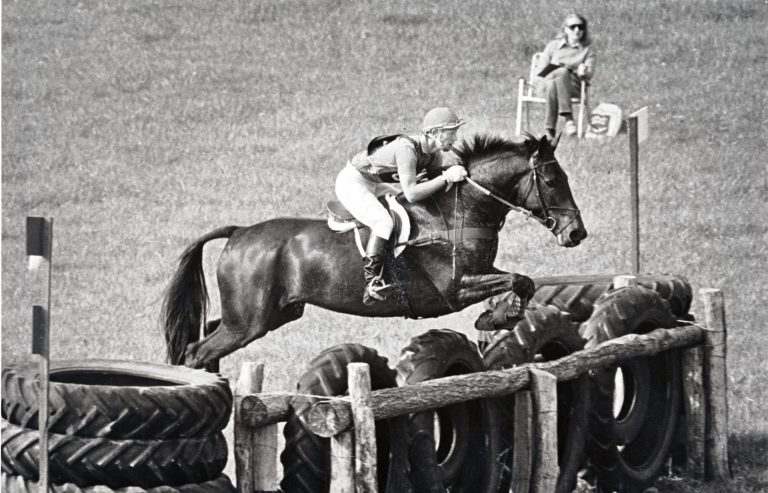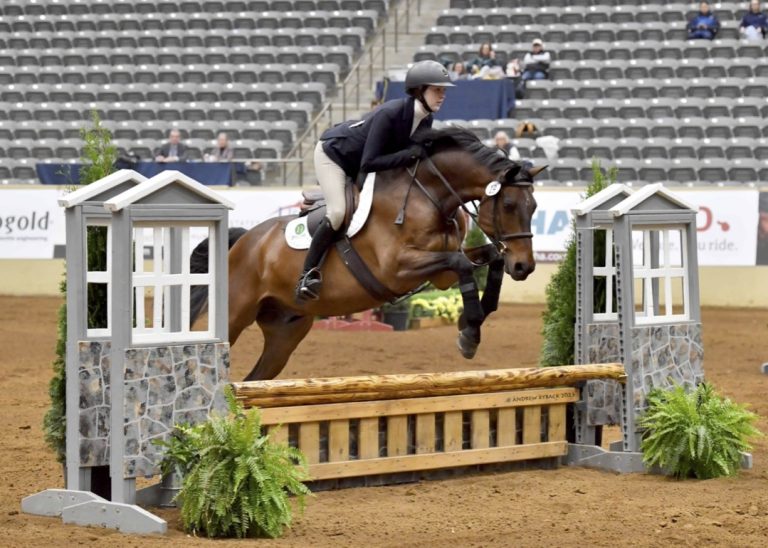 Brianne Goutal and Nice de Prissey compete at the Winter Equestrian Festival. | © SPORTFOT
Brianne Goutal and Nice de Prissey compete at the Winter Equestrian Festival. | © SPORTFOTSue normally gets a lot of energy for her jumping lessons. She gets on her horse, checks her girth, steps into two-point and looks intently around the ring, noticing the jump heights and imagining possible courses for the day. Sue’s barn mate Addison is very calm; at horse shows she loves to spend time with her friends and takes naps to pass the time. Her heart rate stays very low and she has to fire herself up to remember the details of her ride plan. Sue’s and Addison’s energy styles are quite different, yet both are valuable in their own ways.
You have a habitual energy style that your body generates to help you ride your horse. It is a default setting for how you unconsciously gather yourself together to accomplish your goals. This energy style is something that has evolved over time, through your personality, experiences, learning and a host of other factors. The best way to utilize your style to its fullest is first and foremost to acknowledge, accept and value it for all of the things it can do for you before you set about fine-tuning it.
Brianne Goutal: Energy Awareness in Action
Brianne Goutal is a successful young show-jumping professional who has ridden for Nations’ Cup teams, competed at the World Cup and won the American Gold Cup. She also holds the distinction of being the first junior rider to win all four national hunter seat equitation finals. The year she achieved this remarkable feat she was also a part of an equestrian reality TV show called “Horse Power: Road to the Maclay,” which tailed a group of juniors throughout their indoor season—and featured Brianne’s clutch, pressure-filled win of the 2005 ASPCA Maclay National Championship. Brianne’s resume and amazing consistency demonstrates skill, composure and willingness to not only use her personal strengths but also fine-tune them to make her stronger.
“I think that managing the horse’s energy is very similar to managing people’s. You have nervous horses, you have calm horses and you have horses that are very high energy on the first day and then all of a sudden they are cooked.
“We always say that the best setup for a horse is to feel fresh in his body and quiet in his mind. I think it’s the exact same for a person.
“I’m overly calm. [In the equitation] I was surrounded by a group of very successful people in a regimented system. … I never really had a chance to fall out of line. For example, the year I won Maclay finals I almost missed the flat.
“And though I never thought about it this way before, it may have been kind of advantageous for me to feel that extra auxiliary pressure [of the TV show].
“I feel very strongly that when I have prepared and done my homework I have much better results. … I don’t have a religious routine; it’s more that I stay aware of my frame of mind and mood. … I have a music playlist I listen to and I try to keep myself busy.
“It’s mainly about understanding yourself and what you need and what helps or works against you.”
Energy Styles
Let’s begin with an understanding that every day is unique. You arrive at the barn with a slightly different mood, physical state and focus and with a varied constellation of experiences. What is important to note, however, is that you also have a typical “oomph level” that your body generates for you to ride your horse. This style is often quickly described with words like intense, nervous, focused, mellow, lackadaisical, anxious, up-and-down or relaxed (more on these adjectives later). Most important is that you learn to appreciate what this energy style and power level give you before you go about molding and shaping them as needed. On any given day (whether you are on the mounting block, at the back gate or starting out on a trail ride) your energy style is just a starting point.
Acknowledge Your Style and Its Strengths
Think about your typical day at the barn—how do you feel most of the time? What is your energy level likely to be? Before you answer, let’s talk about the descriptive adjectives that are so often utilized to describe how we feel. For example, “nervous,” “tense,” “relaxed” or “flat.” Although we can all understand these terms, they can also act as labels that fail to take the bigger picture into account and leave you feeling stuck. Let’s pause to go a step further and learn how any energy style has the potential to have a positive impact on your ride.
To demonstrate, consider Sue, one of our riders from this article’s opening. She has a high-energy style and in the old days she might have told you, “I’m just a nervous person and I tend to get tense; it’s just how I am.” Upon learning the value of examining her energy style, she knows to go further to understand that “nervous” is simply a bunch of energy her body created because it anticipates a riding challenge (for example, a jump lesson). Sue is then able to reframe and redefine her style to appreciate what it does for her. “I have a lot of energy when I get to the barn. It helps me do my chores efficiently so I have time to do my preparation strategies like stretching and visualizing before my lesson.” You can see how this statement is a more constructive way of interpreting the energy she has and reminds her how she can put it to good use.
Your Style is Not Static
Yes, your energy style is a starting point, but always remember that your style is not fixed; it is malleable. Once you have appreciated and directed your energy appropriately, you can use any number of tools to then adjust it to an even more optimal level for performance. The right techniques can help you adjust and shape your energy as needed to fit the day, ride, class or situation. Ideally, with education and practice, you will feel that your energy is on tap or that you have control over it similar to the volume of your music.
Addison, our other rider, appreciates that she stays very low energy during her down time at shows. This allows her to conserve energy during long days as well as assists her in handling any external pressures (parents, trainer, qualifying goals, etc.). While this is adaptive, Addison also recognizes that before she gets on her horse she needs to elevate her energy to be sharp, focused and on point during her class. Addison has a motivating music playlist she listens to as she gets ready to show and during her preride routine she makes sure she does some light exercises and stretching to get her heart rate activated.
“Everyone who wins is so relaxed.” “She never gets nervous.” “He’s got ice water in his veins.” You can’t watch anyone succeed or win or ride fabulously and think that you completely understand his or her energy style and internal workings. Be careful not to put other riders on a pedestal while at the same time critiquing your personal energy style. What happens under the surface is that rider’s personal job—all you really have to do is understand your own energy patterns, use them to your advantage and then fine-tune as necessary. Appreciate first, adjust second and, as always, happy riding!
Tonya Johnston’s book, Inside Your Ride, is available from the EquineNetworkStore.com here
This article originally appeared in the September 2016 issue of Practical Horseman.










